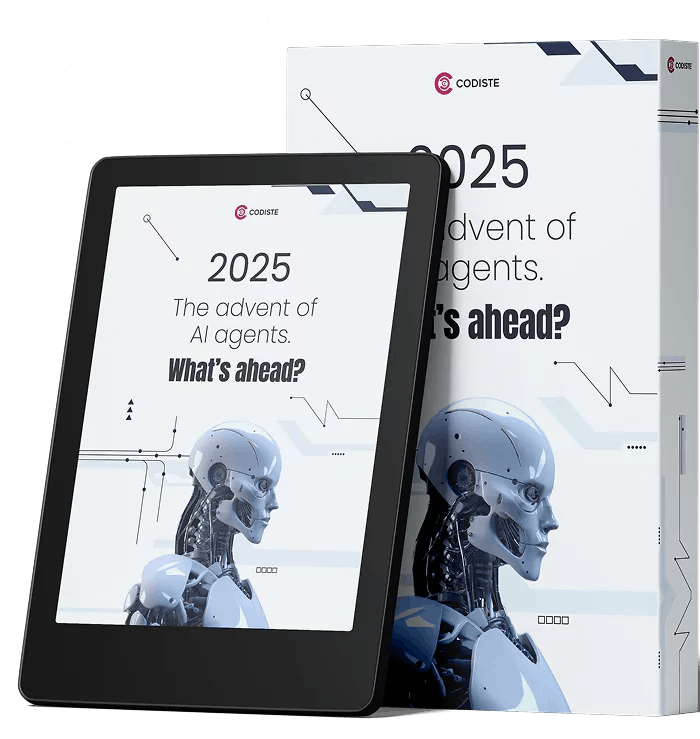
,
When AI agents emerged, we were skeptical about their ability and capability to autonomously perform tasks, make decisions, and interact with users across various domains, from virtual assistants like Siri and Alexa to OpenAI's GPT-4o advanced chatbots that can handle customer inquiries and even recommend products.
Intelligent systems leverage Al to analyze data, understand user inputs, and execute actions efficiently. While traditional AI agents require extensive coding and technical expertise, the rise of no-code platforms has redefined the landscape, making AI accessible more than ever before.
No-code AI has modified how businesses leverage Al. Now, any entity without an understanding of data science, technology or machine learning can also deploy AI models. Modern, no-code AI agent development makes it possible for anyone to build these agents without writing any code.
Now, agents can automate many repetitive and manual tasks. In this article, we will uncover how AI agents are here to take over.
How No-Code Simplifies AI Agent Development
Many current platforms allow users to automate processes and create AI tools with no-code platforms through intuitive visual interfaces by eliminating programming. These platforms have democratized technology, allowing businesses to integrate intelligent, adaptive systems into their operations without a steep learning curve or needing a dedicated development team.
What are the benefits of choosing No-Code Tools for AI Agent Development?
The synergy between AI agents and no-code platforms creates new possibilities throughout, allowing businesses of all sizes to design and deploy AI-driven workflows tailored to their specific business needs. Let us see how companies can get the best out of these AI agents:
- Contributes to efficiency
No-code platforms can develop and deploy AI agents in weeks or, at times, within days, compared to the months required for traditional coding methods, reducing costs by up to 90% for businesses. - Bridging expertise
No-code tools equip domain experts to contribute to AI development directly. Leading to more targeted and effective solutions focused on specific business challenges. - Democratization of AI
Everyone can access these agents; this accessibility lowers entry barriers for individuals and organizations, enabling a wider range of users to experiment with and implement AI technologies. - Improved collaborations
When non-developers participate in the creation processes of AI agents, this collaboration between technical and non-technical teams fosters better project outcomes. - Tailored solutions
Built-in customization options are a pattern among no-code agents, allowing users to design AI agents that meet their specific needs. This flexibility enables adjusted workflows and integration of various data sources without any extensive programming skills.
This combination streamlines processes, enhances customer interactions, and brings the power of AI to a broader audience.
Now, as we move forward, it becomes crucial to understand what platform can be the optimal choice for your business, so let's check out what the right no-code development platform is.
Key Considerations When Choosing a No-Code Platform
Businesses are equipped with all the necessities they need to survive in their ecosystem; thus, understanding how well an AI agent builder integrates with your current systems will help determine whether it can scale with your business and provide the flexibility you need to stay competitive.
You can coansider asking the following questions
- Does the platform provide a low-code interface with natural language instructions?
- Can the AI agent builder seamlessly connect to CRMs, core banking systems, or other AI APIs?
- Does it offer enterprise-grade security for sensitive data?
- Does it provide real-time data insights for better decision-making?
- Are pre-built workflows available for quick setup?
If all your questions are answered, then you can go forward with the platforms to choose from, select the tool that suits your requirements, and you are good to go.
Top No-code AI agent development platforms
Be it intuitive interfaces, pre-built components or drag-and-drop functionalities, everyone can now create AI-powered agents. Here are a few of the finest platforms to look out for.
1.Bolt is a rapid application development platform that emphasizes speed and ease of use through intuitive drag-and-drop interfaces and extensive integration options.
- Visual application builder
- Quick deployment options
- Rich component library
- Custom integration tools
2. Dify a comprehensive open-source platform that seamlessly integrates Backend-as-a-Service with LLMOps, enabling both technical and non-technical teams to build sophisticated AI agents through an intuitive interface.
- Rapid prototyping with visual workflow builder
- Enterprise-grade API infrastructure
- Rich template library for common use cases
- Active community support and detailed documentation
3.Replit is known for its collaborative development environment, which makes AI development accessible through real-time collaboration and comprehensive learning resources.
- Live collaboration features
- Multi-language support
- Educational resources
- Active community support
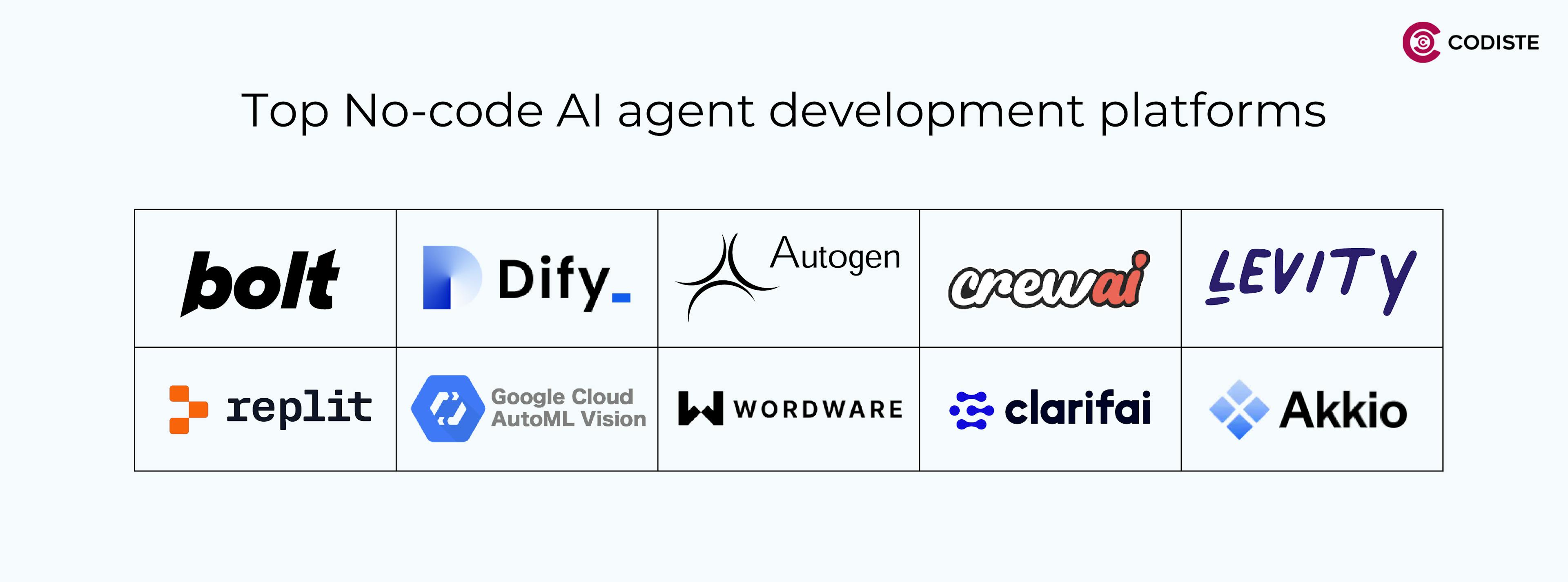
4.Google AutoML Google's enterprise solution democratizes machine learning by automating complex model training while maintaining professional-grade accuracy and seamless cloud integration.
- Automated ML model selection and optimization
- Production-ready deployment infrastructure
- Advanced data preprocessing capabilities
- Native integration with Google Cloud services
5. CrewAI is a specialized workflow automation platform that excels at orchestrating complex business processes through collaborative AI agents, making process automation accessible to business users.
- Visual process designer for complex workflows
- Built-in team collaboration tools
- Scalable multi-agent architecture
- Real-time monitoring and optimization
6.Levity AI transforms business workflows into automated processes with this intuitive platform that specializes in trigger-based automation and seamless integration with existing systems.
- Custom trigger and action design
- Deep business process integration
- No-code automation builder
- Robust error handling and monitoring
7.AutoGen is an advanced framework that enables sophisticated multi-agent collaboration systems while maintaining accessibility for non-technical users through automated workflows.
- Multi-agent orchestration system
- Automated task delegation
- Built-in optimization algorithms
- Extensive integration capabilities
8. Wordware is a versatile AI development toolkit that bridges technical and non-technical needs through rapid prototyping and an extensive template library.
- Quick deployment capabilities
- Cross-functional collaboration tools
- Customizable templates
- Comprehensive testing tools
9. Akkio is a Business-focused predictive modelling platform that excels in transforming complex data into actionable insights, particularly for sales and marketing applications.
- Advanced forecasting algorithms
- Industry-specific templates
- Visual analytics dashboard
- Automated data preprocessing
10.Clarifai is a specialized platform focused on computer vision and NLP that offers end-to-end AI lifecycle management through an accessible visual interface.
- Pre-trained model library
- Custom model training
- Visual development interface
- Comprehensive API access
These platforms represent some of the best options with robust features that cater to multiple business needs without the need for extensive coding knowledge.
Now that we are aware of the prerequisites to choosing the right platform for our AI agent development, we will take a look at how we shall proceed with the actual process.
Steps to build AI agent without coding
By following certain steps, businesses can successfully create and deploy an effective agent using no-code platforms. Here's a concise outline that guides users to create an AI agent without any coding knowledge:
- The objective behind your AI agent
Determine the specific problem your AI agent will address, such as customer support or product recommendations. This clarity will guide your design and functionality. - Choosing the right platform
A suitable no-code platform for your project is dependent on the category of the agent you might need for your business. - Set up your project.
Create an account on your chosen platform and set up your AI project. Follow all the essential guidance to configure your initial settings. - Outline your conversational flow.
Use the platform's editor to map out how users will interact with your AI agent. Ensure the conversation flows naturally and logically.
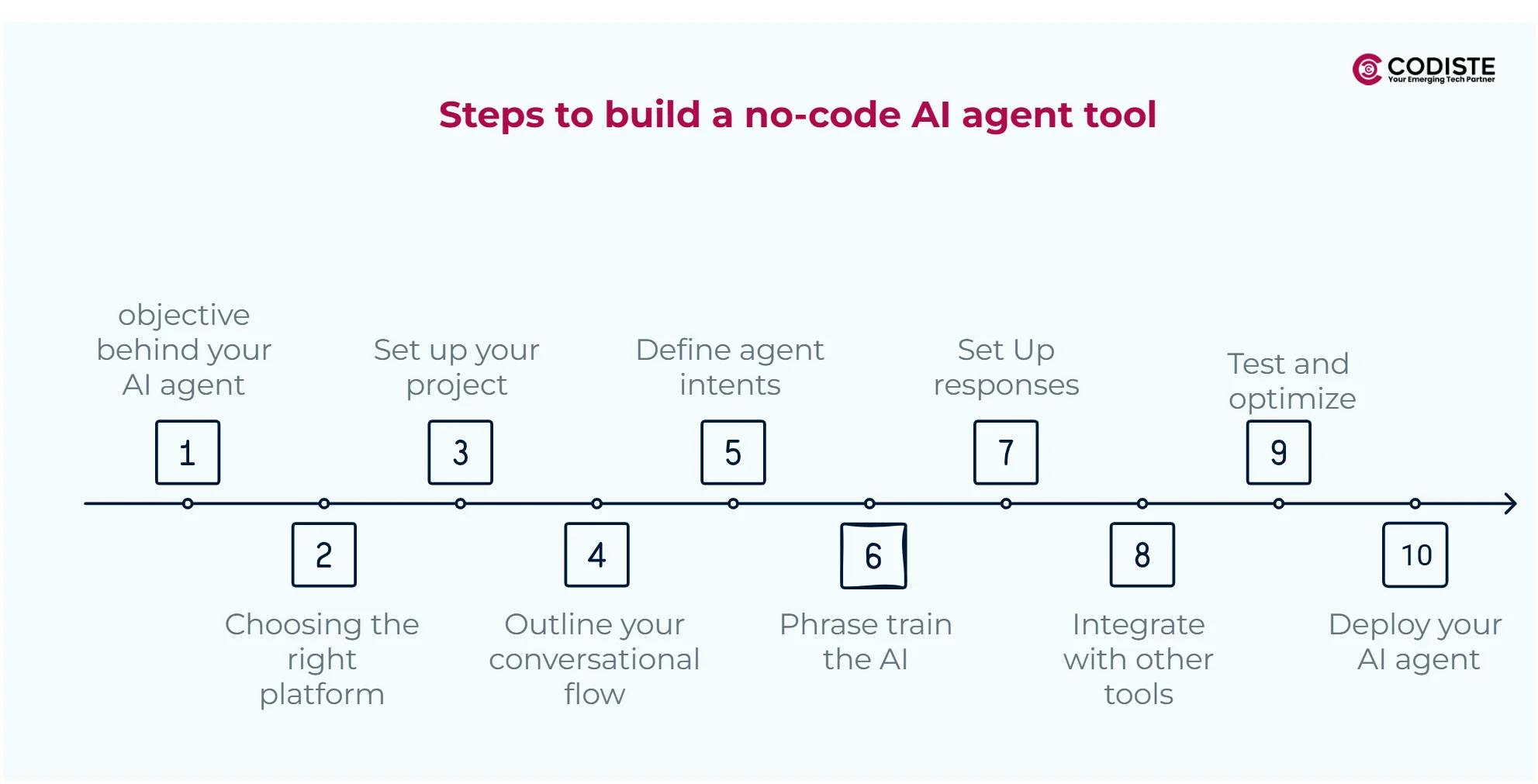
- Define agent intents
Identify and define intents that represent the purpose of user messages (e.g., "checking order status"). This can help the AI understand user queries effectively. - Phrase train the AI
Provide sample phrases for each intent to train your AI agent on various ways users might express their needs. This training improves its understanding and response accuracy. - Set Up responses
Customize responses for different intents, using text, images, or actions (like scheduling appointments) that enhance user interaction. - Integrate with other tools.
Enhance functionality by integrating your AI agent with third-party tools such as CRM systems or email platforms, allowing for more complex interactions. - Test and optimize
Conduct thorough testing using simulation environments provided by the platform. Gather feedback to identify areas for improvement and optimize performance. - Deploy your AI agent
Once testing is complete, deploy your AI agent to your website or application. Monitor its performance using built-in analytics tools to ensure it meets user expectations.
Following the steps mentioned earlier will simplify development and empower non-developers to leverage AI technology to enhance customer interactions and automate tasks effectively.
Once you are in the phase where your AI agent is ready and active, there are certain aspects to upkeep these entities now and then for the smooth running of your operations, and here are some practices to make this happen.
6 Key Strategies to Maintain Your AI Agent's Performance
Ensuring high functionality and optimal performance for your AI agent's businesses needs to consider this guide for success:
1.Identifying clear objectives
The more transparent the purpose and scope of your AI agent, the better its performance, as identifying specific problems will help this agent serve its target audience well. This clarity will drive the design and functionality of the agent, ensuring it meets user needs effectively.
2.Fine-tuning and customization
Leverage customization options available in your AI models. If your agent requires domain-specific language processing or specialized tasks, ensure that the model allows for fine-tuning. This adaptability can significantly enhance the agent's performance in its intended context.
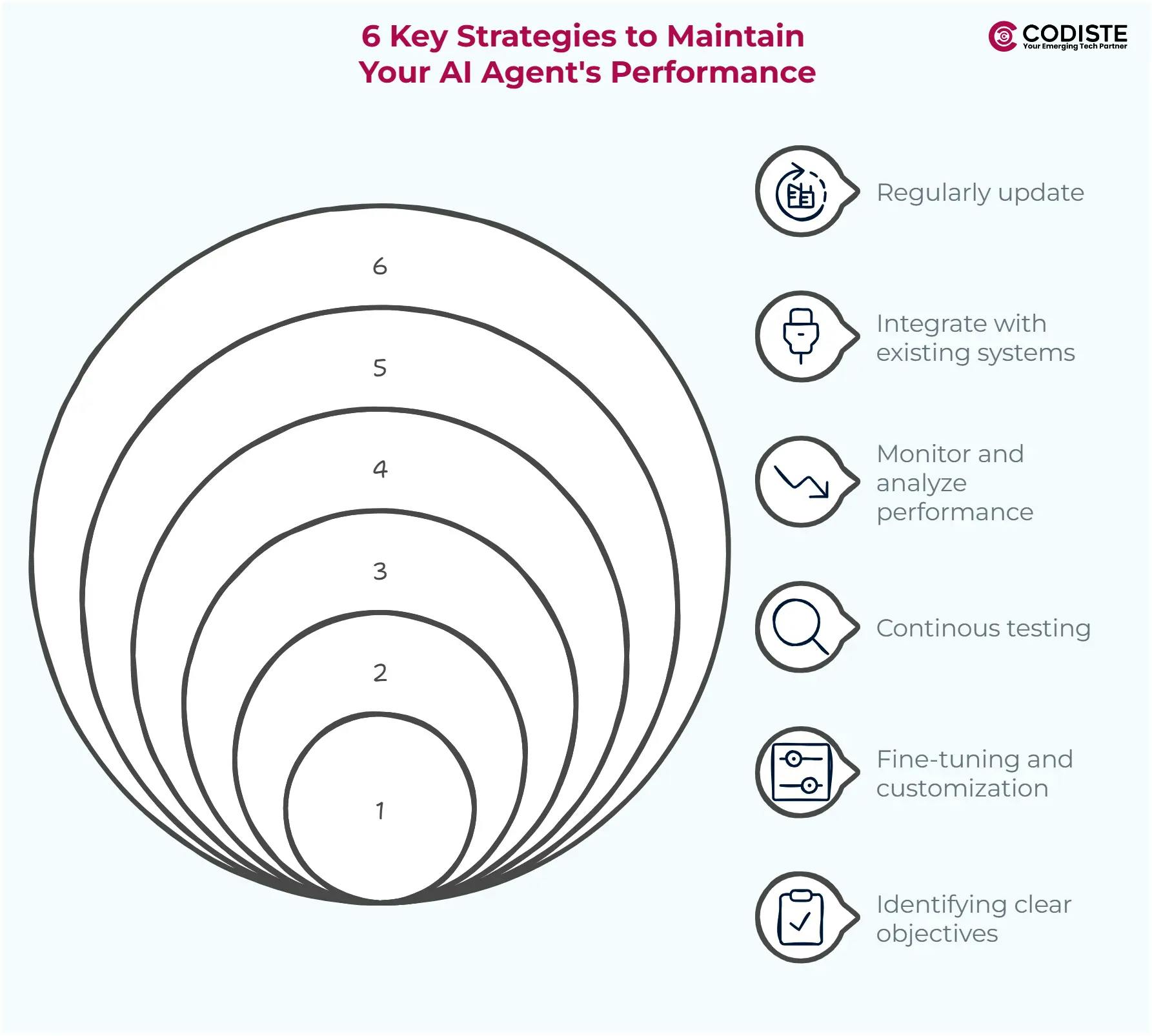
3.Continous testing
Continuous and extensive testing can help identify any biases or unexpected glitches in an AI agent's behaviour. Regularly testing the agent's performance against defined metrics will ensure it meets quality standards for refining interactions, thus improving user experience.
4.Monitor and analyze performance
Implement robust monitoring tools to track the agent's performance in real-time. Analyze user interactions and feedback to gain insights into areas for improvement. This ongoing evaluation helps in making data-driven adjustments that enhance the agent's effectiveness.
5.Integrate with existing systems
Ensure that your AI agent can seamlessly integrate with existing business systems and workflows. This integration is vital for maximizing efficiency and ensuring that the agent can access the necessary data to perform its tasks effectively.
6. Regularly update and retrain the agent based on new data
The process lies in the constant; as a business, you need to continuously gather new data and user feedback to improve your AI agent's performance. Regular updates over time and retraining intelligence ensure it remains relevant and effective over time.
Progress is a continuous process, and by following this guide, you can lead to better AI agent performance, ensuring efficient operations while meeting all the end user needs simultaneously; this will keep your AI solutions relevant in an ever-evolving landscape.
Conclusion
The adoption of no-code tools for AI agent development has refashioned how businesses approach AI. With cost reductions, rapid deployments, empowering non-developers, and better customer satisfaction, these no-code platforms make it easier than ever to leverage AI agents effectively. As the market continues to evolve, no-code solutions will likely become part of significant importance for businesses aiming to lead in their respective industries.
Key Takeaways
- In our no-code AI agent tutorial, you have understood that building an AI agent using no-code tools is an efficient, cost-effective, and accessible way for businesses to leverage AI capabilities without requiring extensive technical expertise.
- By selecting the right no-code platform, defining clear objectives, and following a systematic approach, businesses can create tailored AI solutions that streamline workflows, enhance customer engagement, and optimize performance.
- AI agent's success lies in continuous testing, regular updates, and seamless integration with existing systems to ensure the AI agent remains effective and relevant over time.
Curious to transform your business with AI agents? Explore the potential of no-code platforms and unlock the power of automation today! Whether you're looking to streamline operations, improve customer interactions, or innovate at scale, our resources and expert guidance are here to help. Contact us codiste now to kickstart your AI agent development journey.



Top Industries Benefiting from AI Voice Assistants in Customer Service
Know more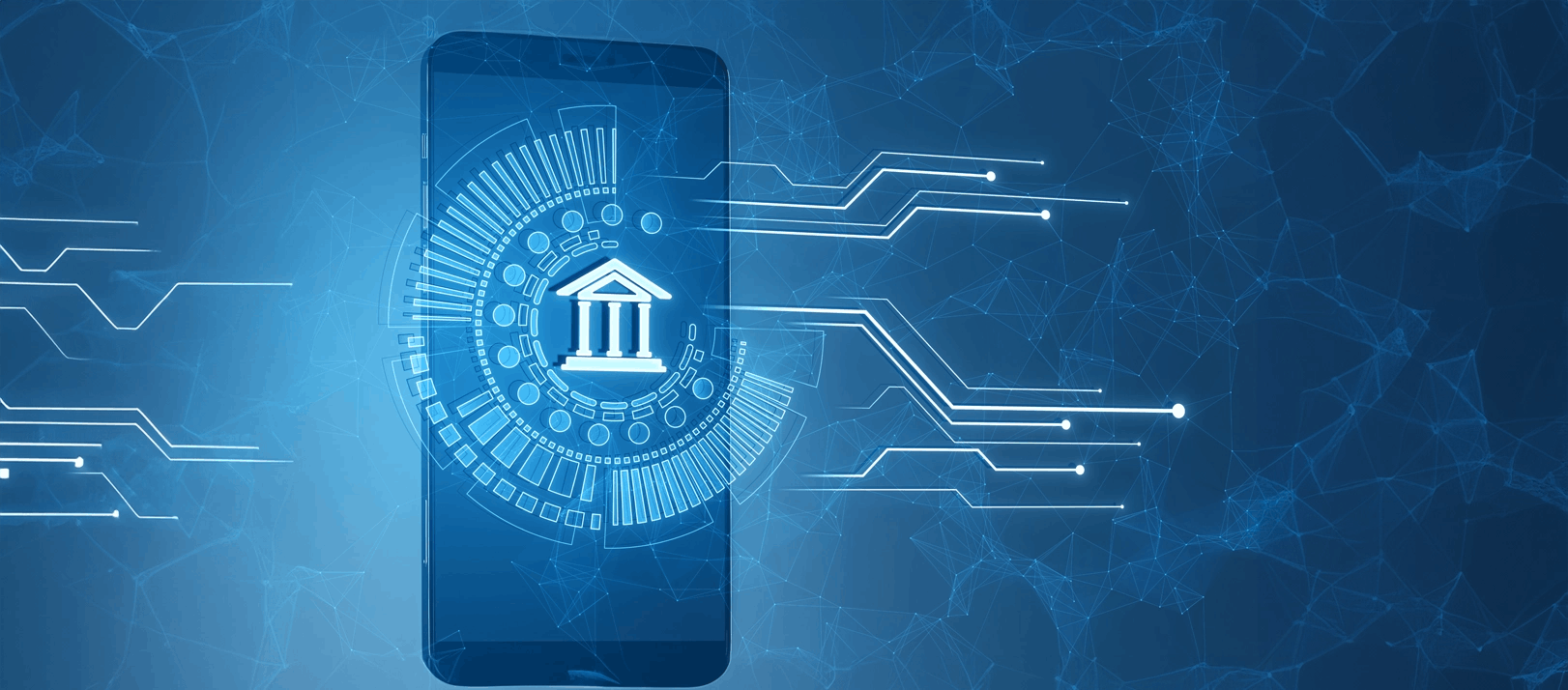
Building a Compliance-First Neobank: Tech Stack, AI Models, and Regulatory Architecture
Know more

